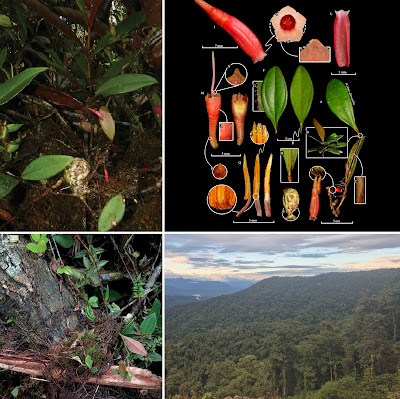 |
| Thibaudia shagmiana M.M. Jiménez, Luteyn & Darío García, in Jiménez, Luteyn, Kuethe, García, Lapo-González, Garzón-Suárez et Iturralde. 2025. |
Abstract
Background: The neotropical genus Thibaudia Ruiz & Pav. ex J.St.-Hil. (Ericaceae), comprises about 70–75 species and is distributed from Honduras in Central America, through the central Andes south to Bolivia, and eastward to Suriname and Brazil in South America. Ecuador is one of the countries with the greatest diversity of the genus, including 18 species, 12 of which are endemic. Within southeastern Ecuador, the Cordillera del Cóndor is a region characterized by exceptionally high levels of plant endemism, largely due to its unique geology. Recent botanical explorations across this area have led to the discovery of several new species in recent years. Among those was a peculiar species of Thibaudia that is distinct by having exclusively cauliflorous inflorescences in which the pedicel is articulated with the calyx and the filaments are connate. This species is here described and illustrated as Thibaudia shagmiana sp. nov.
New information: A new species, Thibaudia shagmiana, is described from the Cordillera del Cóndor in eastern Ecuador. It is distinguished by having a scrambling habit, provided with lignotubers, lanceolate leaves that are verticillate at the apex of branches, solitary and glabrous flowers, caducous bracts and bracteoles, stamens shorter than the corolla, anthers with prognathous thecae, and laterally connate tubules. The taxonomic similarities of the new species are discussed, and information about its distribution, habitat, and conservation is provided.
Keywords: Andean Tepui, Neotropics, new species, northern Andes, rainforest, Zamora Chinchipe
 |
| Thibaudia shagmiana in situ. A Habitat of the species. B An individual on a fallen tree branch. C Holotype of the species on a tree trunk. |
Thibaudia shagmiana M.M. Jiménez, Luteyn & Darío García, sp. nov.
Diagnosis: Thibaudia shagmiana is distinguished from other members of the genus by its combination of scrambling plant (to 30 cm) and lignotuberous with branches that root from nodes when in contact with mossy litter, lanceolate leaves that are pseudoverticillate at apex of branches, caducous bracteoles, solitary-flowered or 2-fasciculate inflorescences on short rachis, glabrous flowers produced in axils of lower leaves or on leafless branches, cupuliform calyx with a cylindrical limb, corolla with trigonous lobes, stamens ⅔ the corolla length, staminal filaments connate, prognathous thecae, laterally connate tubules, and a style that is shorter than the corolla.
Etymology: The new species is named after the Cordillera de Shagmi, a west-facing slope of the Cordillera del Cóndor region in Zamora-Chinchipe province, Ecuador, where this species was found.
Marco M. Jiménez, James L. Luteyn, J. R. Kuethe, Darío García, Nadia Lapo-González, Henry X. Garzón-Suárez and Gabriel A. Iturralde. 2025. A New Species of Thibaudia (Ericaceae, Vaccinieae) from the Cordillera del Cóndor in Ecuador. Biodiversity Data Journal. 13: e157044. DOI: doi.org/10.3897/BDJ.13.e157044


